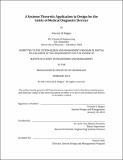| dc.contributor.advisor | Qi D. Van Eikema Hommes. | en_US |
| dc.contributor.author | Balgos, Vincent H | en_US |
| dc.contributor.other | System Design and Management Program. | en_US |
| dc.date.accessioned | 2013-02-13T21:23:41Z | |
| dc.date.available | 2013-02-13T21:23:41Z | |
| dc.date.copyright | 2012 | en_US |
| dc.date.issued | 2012 | en_US |
| dc.identifier.uri | http://hdl.handle.net/1721.1/76814 | |
| dc.description | Thesis (S.M. in Engineering and Management)--Massachusetts Institute of Technology, Engineering Systems Division, System Design and Management Program, 2012. | en_US |
| dc.description | This electronic version was submitted by the student author. The certified thesis is available in the Institute Archives and Special Collections. | en_US |
| dc.description | Cataloged from PDF version of thesis. | en_US |
| dc.description | Includes bibliographical references (p. 87-89). | en_US |
| dc.description.abstract | In today's environment, medical technology is rapidly advancing to deliver tremendous value to physicians, nurses, and medical staff in order to support them to ultimately serve a common goal: provide safe and effective medical care for patients. However, these complex medical systems are contributing to the increasing number of healthcare accidents each year. These accidents present unnecessary risk and injury to the very population these systems are designed to help. Thus the current safety engineering techniques that are widely practiced by the healthcare industry during medical system development are inadequate in preventing these tragic accidents. Therefore, there is a need for a new approach to design safety into medical systems. This thesis demonstrated that a holistic approach to safety design using the Systems Theoretic Accident Model and Process (STAMP) and Causal Analysis based on STAMP (CAST) was more effective than the traditional, linear chain-of-events model of Failure Mode Effects and Criticality Analysis (FMECA). The CAST technique was applied to a medical case accident involving a complex diagnostic analyzer system. The results of the CAST analysis were then compared to the original FMECA hazards. By treating safety as a control problem, the CAST analysis was capable of identifying an array of hazards beyond what was detected by the current regulatory approved technique. From these hazards, new safety design requirements and recommendations were generated for the case system that could have prevented the case accident. These safety design requirements can also be utilized in new medical diagnostic system development efforts to prevent future medical accidents, and protect the patient from unnecessary harm. | en_US |
| dc.description.statementofresponsibility | by Vincent H. Balgos. | en_US |
| dc.format.extent | p. | en_US |
| dc.language.iso | eng | en_US |
| dc.publisher | Massachusetts Institute of Technology | en_US |
| dc.rights | M.I.T. theses are protected by
copyright. They may be viewed from this source for any purpose, but
reproduction or distribution in any format is prohibited without written
permission. See provided URL for inquiries about permission. | en_US |
| dc.rights.uri | http://dspace.mit.edu/handle/1721.1/7582 | en_US |
| dc.subject | Engineering Systems Division. | en_US |
| dc.subject | System Design and Management Program. | en_US |
| dc.title | A systems theoretic application to design for the safety of medical diagnostic devices | en_US |
| dc.type | Thesis | en_US |
| dc.description.degree | S.M.in Engineering and Management | en_US |
| dc.contributor.department | System Design and Management Program. | en_US |
| dc.contributor.department | Massachusetts Institute of Technology. Engineering Systems Division | |
| dc.identifier.oclc | 824176774 | en_US |
